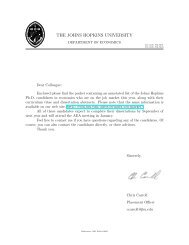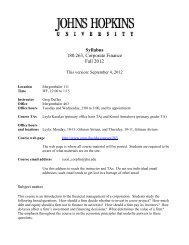WEALTH, DISPOSABLE INCOME AND CONSUMPTION - Economics
WEALTH, DISPOSABLE INCOME AND CONSUMPTION - Economics
WEALTH, DISPOSABLE INCOME AND CONSUMPTION - Economics
You also want an ePaper? Increase the reach of your titles
YUMPU automatically turns print PDFs into web optimized ePapers that Google loves.
cointegrating parameters reported in Table 6. Note that when k’ is substituted<br />
for k, non-human wealth has significant explanatory power for consumption<br />
based on the Phillips-Hansen and Stock-Watson estimates, and<br />
all three estimation techniques produce very similar coefficient estimates.<br />
Moreover, when the value of equity is entered separately with the consumption<br />
function including y, h and k’, it has a negative coefficient that is<br />
statistically indistinguishable from zero. The suggestion is that once we<br />
restrict attention to assets such as housing, currency and deposits, which<br />
have less variable returns and are more widely held, fluctuations in both<br />
human and non-human wealth have important effects on consumption.<br />
A fourth noteworthy result in Table 6 is that while the coefficient on<br />
the relative price of consumption is typically negatively signed as<br />
expected, it is only significant in the Keynesian consumption function.<br />
Moreover, even in the Keynesian consumption function, the coefficient on<br />
the relative price variable is significantly below that on disposable income<br />
(which is nominal disposable income deflated by the GDP deflator). This<br />
suggests that the GDP deflator is preferred empirically in both the<br />
Keynesian and wealth-based consumption functions.<br />
The above inferences all assume that the long-run parameters<br />
reported in Table 6 are constant, but if in fact they are changing through<br />
time, these inferences are invalid. In order to test for this type of<br />
misspecification, Hansen’s (1992) tests for parameter non-constancy for I(1)<br />
processes are applied to the three most interesting long-run equations.<br />
Hansen proposes three tests – SupF, MeanF and Lc – which all share the null<br />
of parameter constancy but differ in their alternatives. SupF tests for a<br />
structural break of unknown timing and is therefore appropriate for determining<br />
if there has been a swift shift in regime, while MeanF and Lc model<br />
the parameters as a martingale under the alternative, so change is viewed<br />
as a gradual process. The test statistics together with their probability values<br />
are reported in Table 7 and refer to the Phillips-Hansen parameter estimates<br />
reported in Table 6.<br />
31




